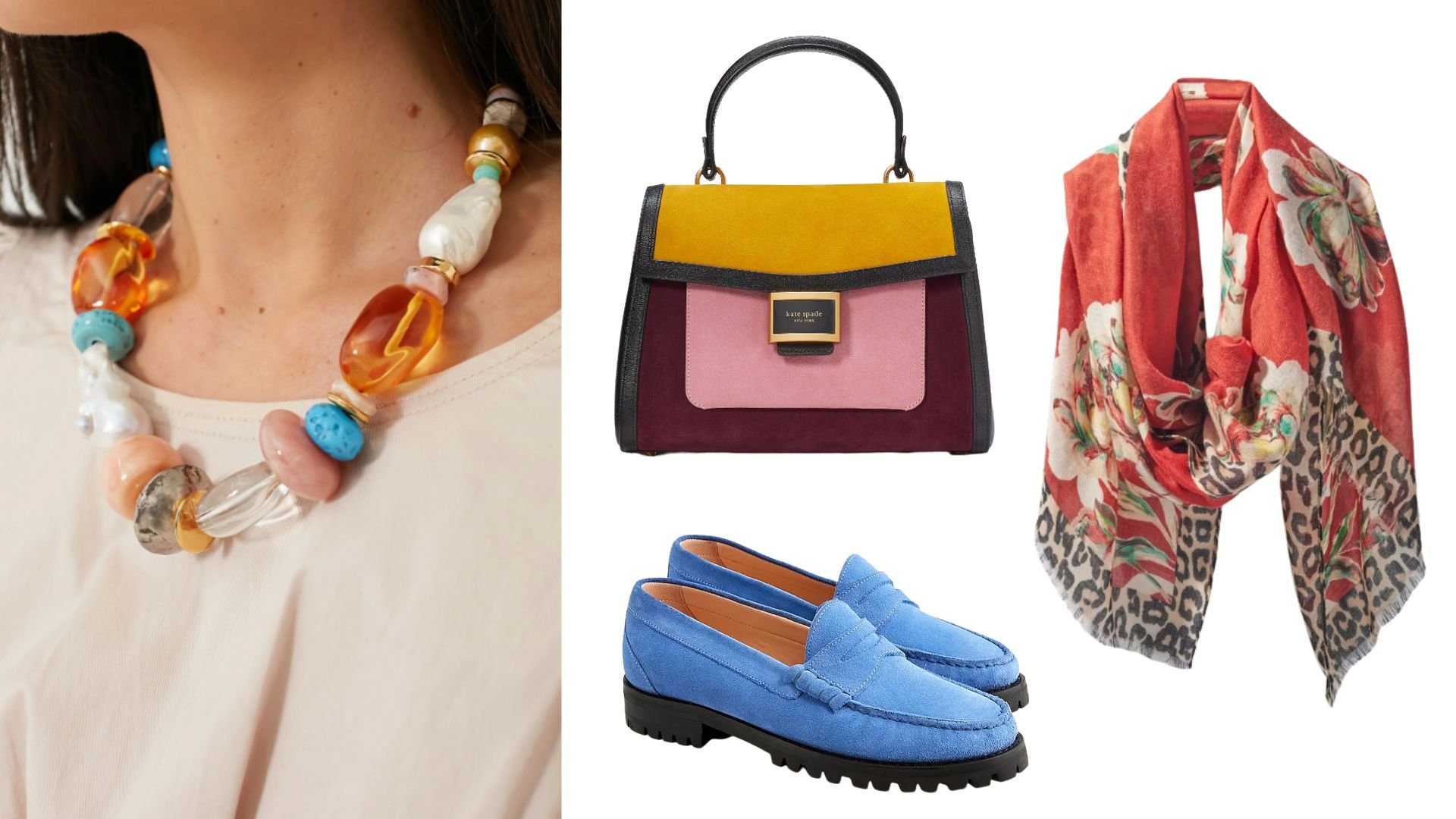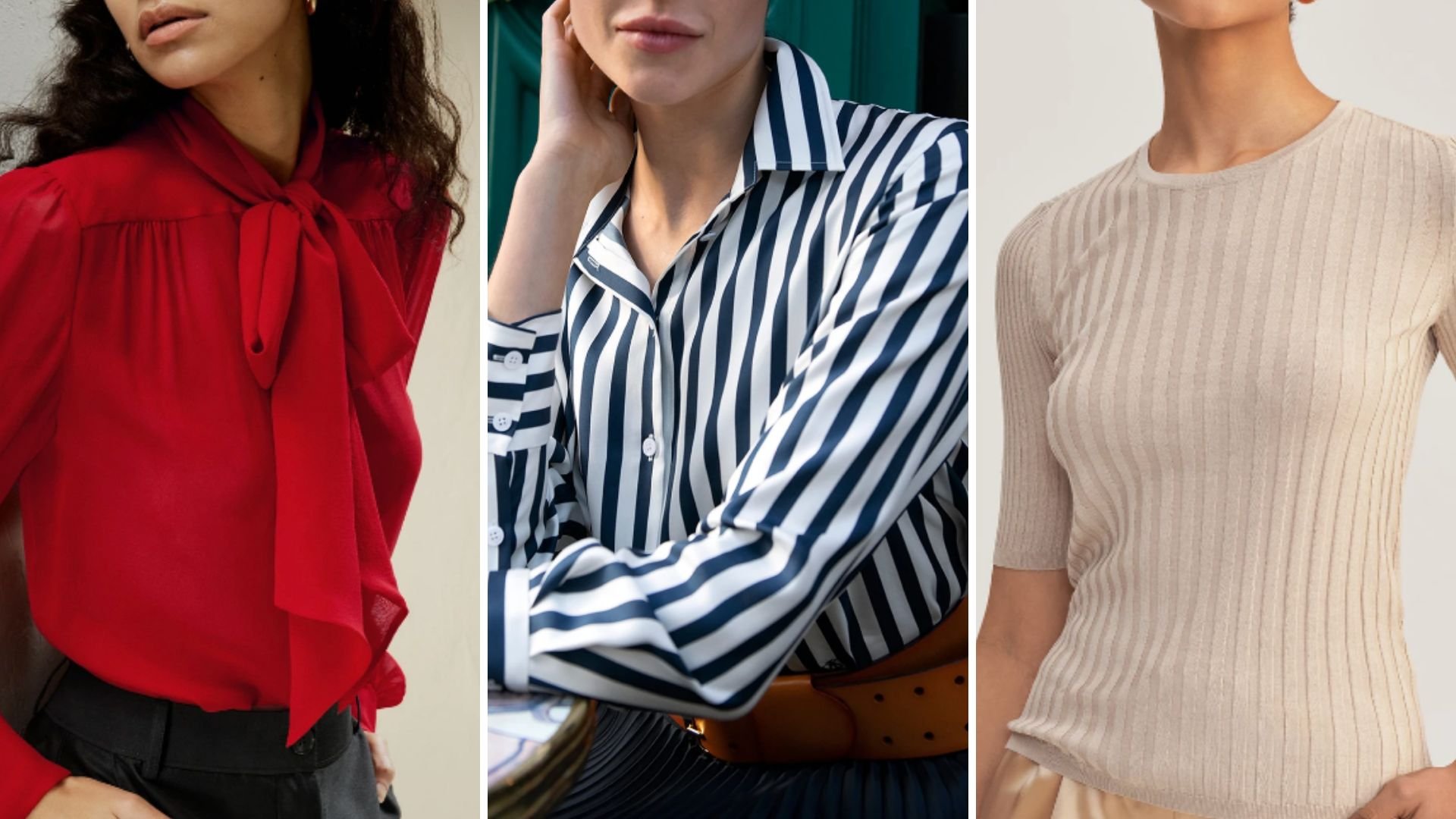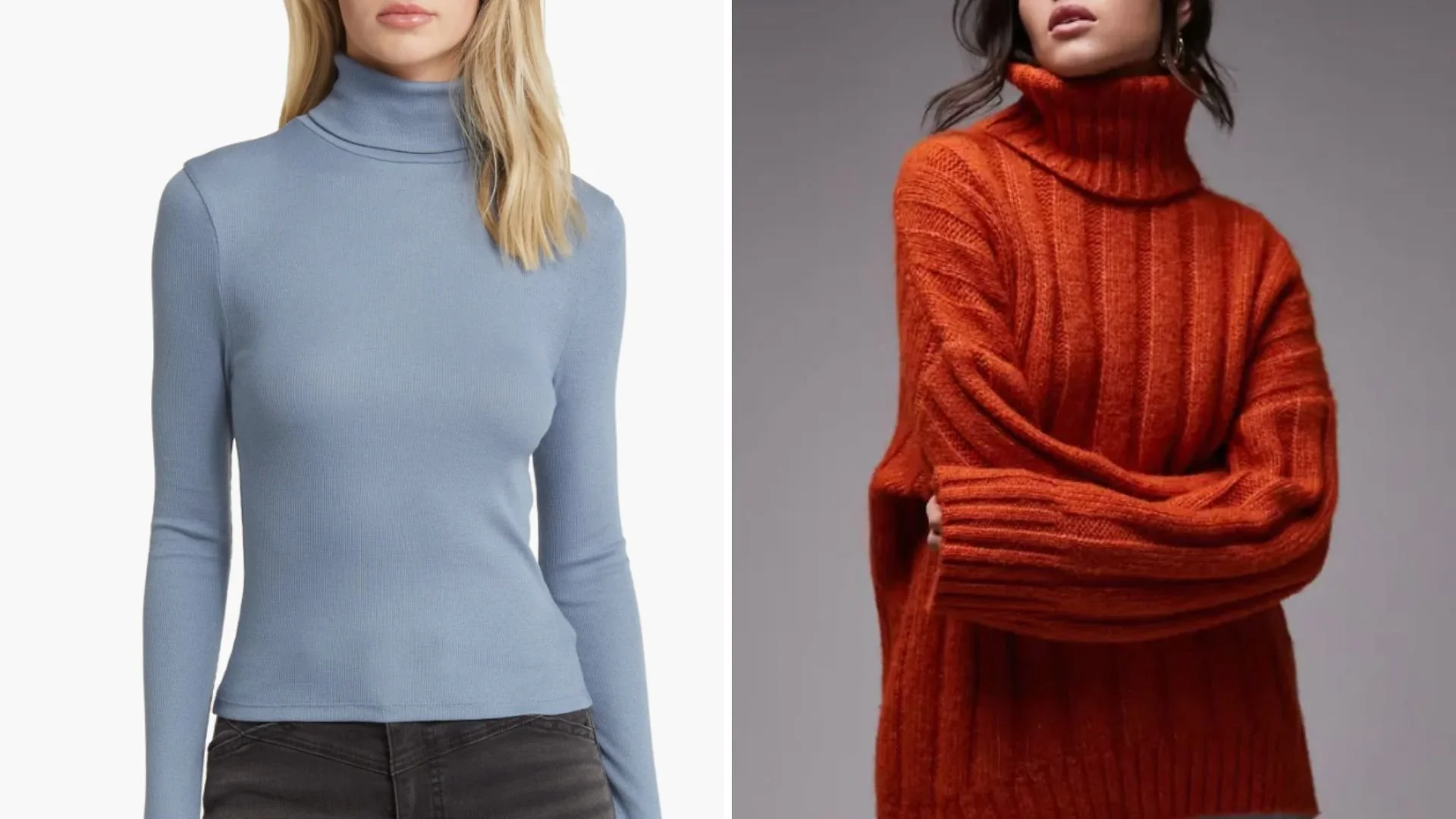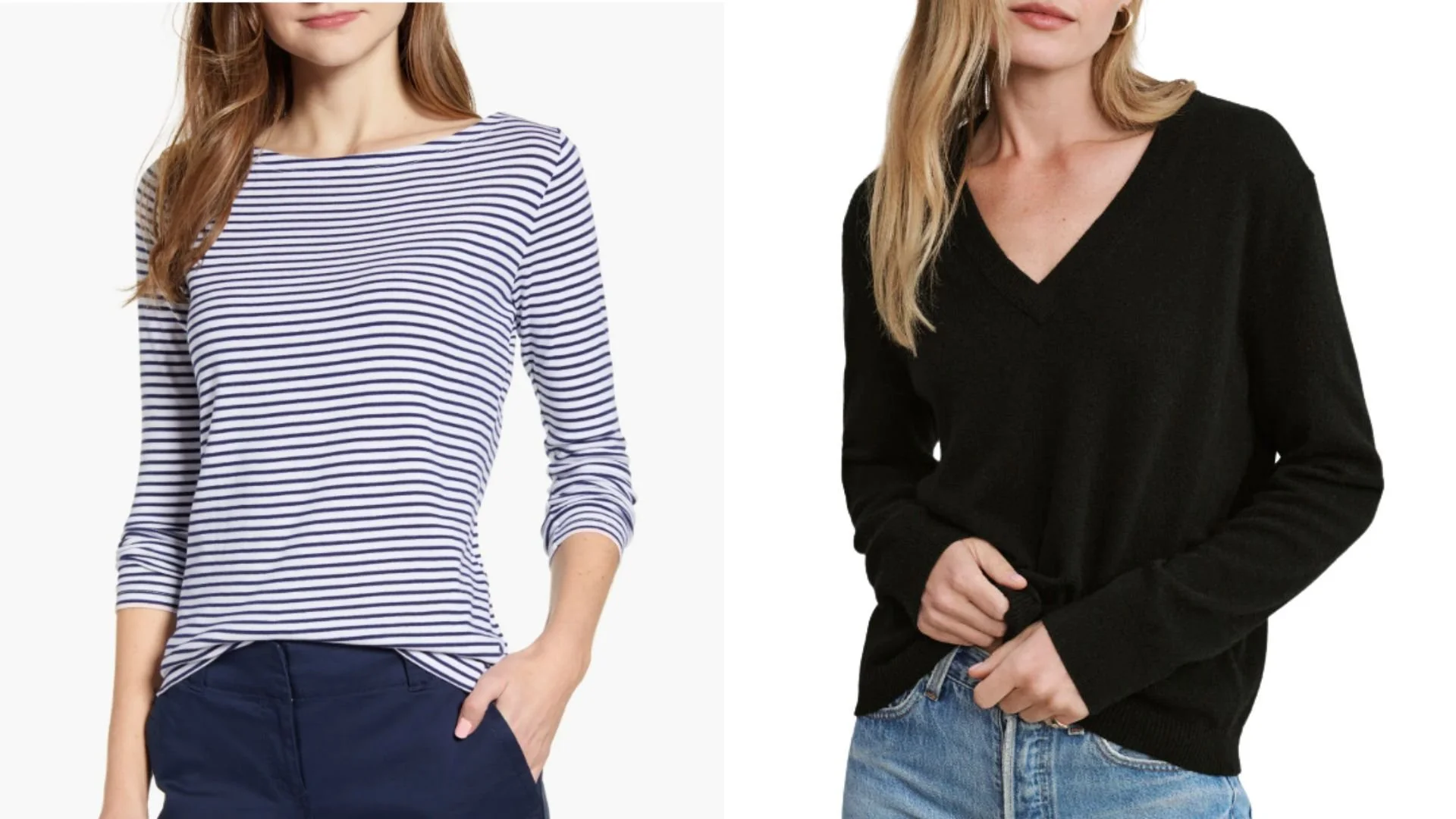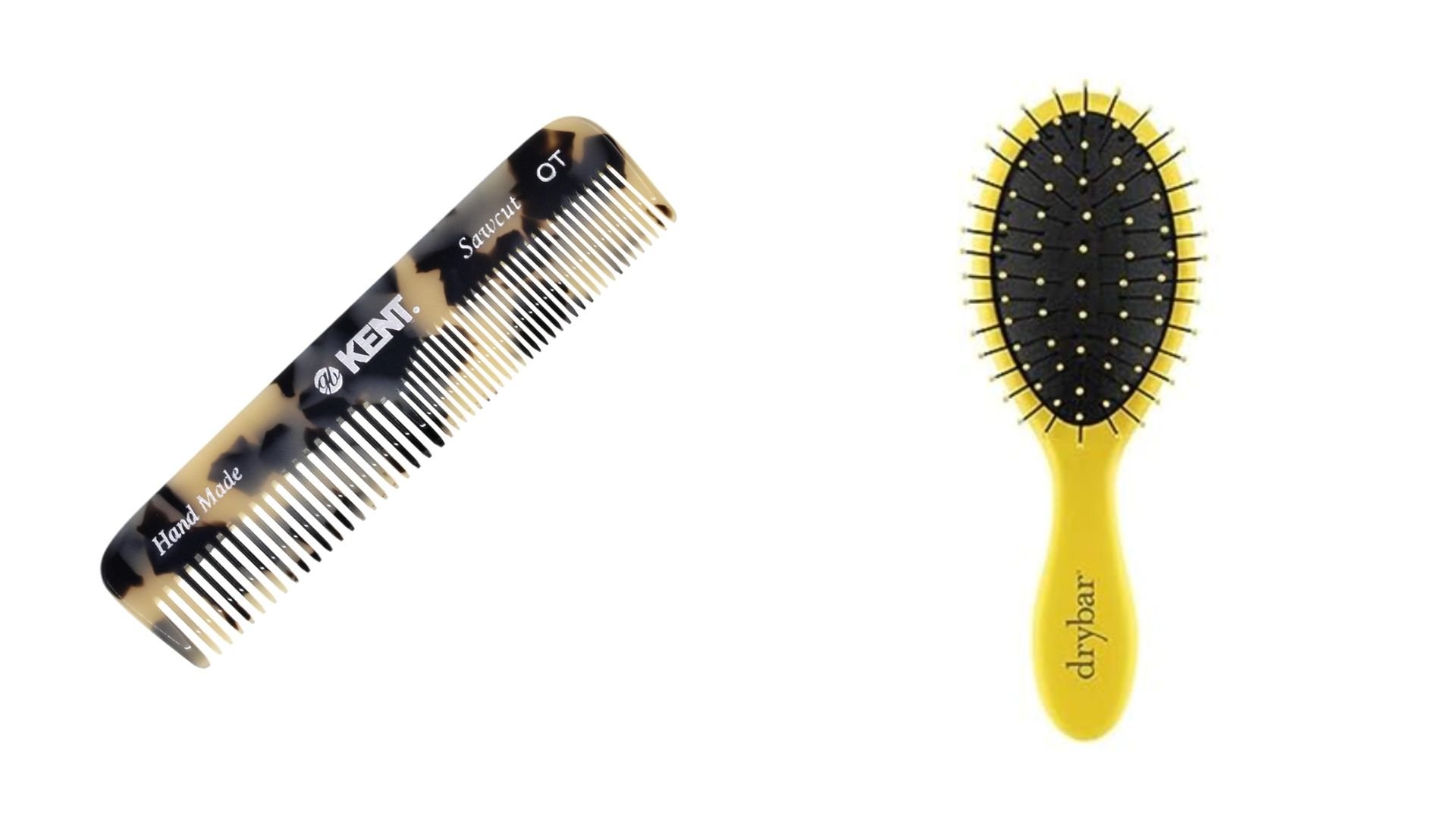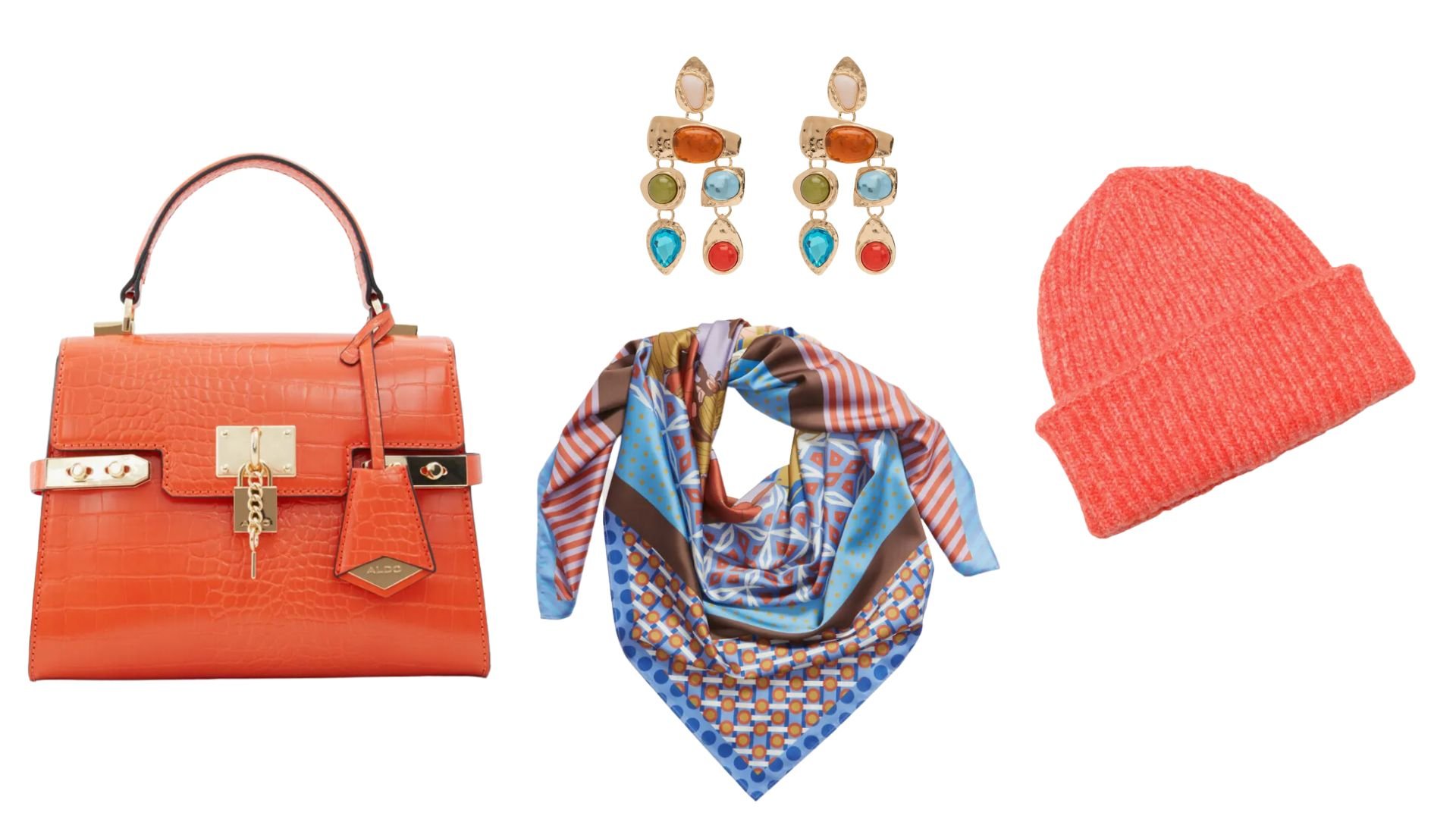10 Fall Fashion Mistakes to Avoid
The season conjures images of golden leaves, pumpkin-spiced lattes, and cozy knits. But as we transition from the easy-breezy summer outfits to the warm and layered fall fashion, there are a few pitfalls that even the most seasoned fashionista might unknowingly step into.
I’ve rounded up 10 little-known fall fashion mistakes to be wary of. You can watch the video or read the blog post below.
This post may contain affiliate links. Please see my full disclosure for more information.
Don’t Make these Fall fashion mistakes
#1. Over-layering
Layering, a cherished fall fashion technique, has been embraced for its practicality and aesthetic appeal. It’s not just about staying warm; it’s also about adding dimension, texture, and versatility to an outfit. However, the art of layering can quickly become a fashion misstep if not executed with finesse.
Understanding the Over-layering Trap: It's easy to get carried away in the excitement of merging summer and winter pieces. The danger lies in piling on too many bulky items, making a look that feels disproportionate and cumbersome. Not only can this make your silhouette appear heavier, but it can also be genuinely uncomfortable, restricting movement and causing overheating.
The Three-Layer Rule: As a general guideline, if you wear more than three layers, ensure they vary in thickness and weight. Start with a thin base, like a cotton tee or a slim turtleneck. The middle layer can be a bit more substantial, perhaps a knit sweater or a long-sleeve shirt. The outermost layer, often a jacket or coat, should offer protection from the elements and be easily removable to adjust to indoor temperatures.
Complementary Choices: Beyond the thickness, the colors, patterns, and textures of your layers should harmonize. Contrasting textures, like a smooth silk shirt beneath a chunky wool cardigan, can add depth and interest. Experiment with color theory by pairing complementary colors or using different shades of a single hue for a monochromatic look.
Adjusting for the Occasion: Different situations call for different layering strategies. A brisk morning walk might demand more layers, while an evening in a warm, crowded venue might mean paring back. Stay attuned to the context, and don’t be afraid to adjust.
Garments featured above Banana Republic Italian Wool Pleated Pants | Siena Italian Wool Cropped Pants | Ramira Flared Pants
#2. Wearing Dark Colors Exclusively
Fall doesn't mean bidding farewell to all bright hues. While burgundies, navies, and olives dominate the palette, a pop of color can break the monotony.
Beyond the Traditional: Fall might be dominated by shades of burgundy, navy, and olive, but that doesn't mean you're restricted to them. There's an entire spectrum waiting to be embraced, even without venturing into summer or pastel territories.
Bold Accents: Think of bright orange, fiery red, golden yellow, or rich purple colors. Integrating such colors through accessories, be it a statement necklace, a bold handbag, or vibrant shoes, can elevate your outfit's dynamic. Featured above Tuckernuck Sunbeam Necklace | J.Crew Blue Suede Loafers | Chico’s Floral Print Oblong Scarf
Pattern Play: Another way to introduce color is through patterns. Geometric designs, abstract prints, or classic checks with colorful twists can be trendy and season-appropriate. Featured above Talbots Paisley Button Front Shirt | Talbots Leopard Print Vest | Talbots Argyle Print Blouse
Balance and Harmony: When playing with bold colors, it's essential to maintain a cohesive look. Pair a brightly colored piece with more muted, classic fall tones to strike the perfect balance.
Your fall wardrobe doesn't have to be a sea of muted colors. You can infuse energy and uniqueness into your autumn outfits by judiciously adding pops of vibrant shades.
#3. Sticking Only to Heavy Fabrics
As the weather gets cooler, we tend to gravitate towards the thickest and warmest pieces of clothing in our closet. While there's no denying the appeal of cozy fabrics during this season, it's worth remembering that not every autumn day calls for heavy gear. A range of lighter fabrics can be stylishly incorporated into the fall ensemble, offering both comfort and versatility.
Breaking the Heavy Fabric Myth: The start of fall doesn't necessarily translate to an immediate dip in temperatures. Many days still echo the mildness of late summer, making it an ideal time to integrate lighter fabrics into daily wear.
The Subtle Stars of Fall Fabric:
Silk: This timeless material isn't just for balmy summer evenings. A silk blouse or scarf can add a touch of refined elegance to any outfit, layering effortlessly with jackets or cardigans. Featured above Lily Silk Bow-Tie Silk Blouse | Lily Silk Almafi Stripe Silk Shirt | Lily Silk Knit Tee
Cotton Poplin: Often used in shirts, cotton poplin is crisp, lightweight, and breathable. Its structured appearance is perfect for professional settings, yet it can easily be dressed down for casual outings. Plus, it layers well under vests, cardigans, and light jackets. Featured above J.McLaughlin Finn Shirt | J.McLaughlin Blossom Print Shirt | J.McLaughlin Finn Shirt in White
Lightweight Knitwear: Not all knitwear is chunky. Lightweight knits in tees, tanks, and turtlenecks are indispensable for fall. They're the perfect middle ground, providing warmth without bulk and layering seamlessly under heavier pieces.
Mastering the Art of Layering: The key to successfully wearing lighter fabrics during fall is understanding and experimenting with layering. A cotton poplin shirt beneath a wool blazer or a lightweight knit tee paired with an open button-down can create a dynamic, textured look that's both functional and chic.
Climate Considerations: As always, the choice of fabric should be attuned to the day's weather. On milder days, lighter fabrics can take center stage, while colder moments might see them playing a supporting role beneath weightier counterparts.
Diversifying fabric choices in the fall not only brings versatility to your style but also ensures you're ready for the season's unpredictable weather swings. Embracing a mix of materials, from silks to lightweight knits, can help create a practical and fashion-forward wardrobe.
#4. Ignoring Shoe Proportions
When curating the perfect outfit, shoes often become the afterthought. However, footwear plays a pivotal role in your ensemble's overall visual balance and proportion. While the concept of mixing and matching is cherished in fashion, it's essential to ensure that the contrasts don’t throw off the harmony of the outfit.
The Oversights in Pairing: Shoe proportions can significantly influence the perception of an outfit's balance. An ensemble's aesthetic flow can be disrupted when there's a disproportionate pairing, like teaming up a heavy, oversized sweater with delicate ballet flats or matching a light, ethereal dress with robust, chunky boots.
Why Proportions Matter: The human eye naturally seeks balance and symmetry. When your footwear is not proportionate to the rest of your outfit, it can create a visual discord that feels 'off' or distracting. This misalignment can sometimes overshadow the individual beauty of the pieces you're wearing.
Guidelines for Proportional Pairing:
Weight with Weight: If you're wearing something bulky or heavy on top, consider a shoe with a bit more substance, such as a sturdy heel or a boot, to balance out the visual weight. Featured above Jenni Kayne Leather Lug Sole Mules | Jenni Kayne Brooklyn Ankle Boots
Light with Light: For flowy, lightweight dresses or skirts, shoes that have a more delicate silhouette, like strappy sandals or sleek heels, can complement the airy nature of the clothing.
Transitional Pieces: Ankle boots or loafers can often serve as excellent transitional footwear, striking a balance when you're mixing lighter and heavier elements in your outfit. Featured above J.Crew Piper Leather Ankle Boots | J.Crew Leather Coin Loafers
Flexibility in Fashion: While these guidelines offer a foundational understanding, fashion is inherently subjective. It’s about personal expression and sometimes breaking the rules. However, being aware of proportions gives you an informed starting point from which you can play, experiment, and make the style truly your own.
In conclusion, the next time you're selecting shoes for your outfit, take a moment to consider the overall proportions. Recognizing and mastering this can elevate your fashion game, ensuring your ensemble feels harmonized from head to toe.
#5. Relying Solely on Denim
While jeans are a go-to for many during the fall, don’t forget about corduroy, wool trousers, or even silk joggers that can be both comfortable and chic.
When the crispness of fall air beckons, many instinctively reach for their trusted pair of jeans. Denim, with its durability and versatile nature, undoubtedly holds a special place in our autumnal wardrobe. However, limiting oneself to only denim can result in missing out on a spectrum of fabrics that are not only seasonally appropriate but also offer a refreshing twist to the usual style narrative.
The Denim Dominance: It's easy to understand the allure of jeans. They're versatile, easy to style, and have an effortlessly casual appeal. But fall, with its mosaic of colors and textures, provides the perfect backdrop to experiment with alternative fabrics.
Exploring Fabric Alternatives:
Corduroy Pants: A quintessential fall favorite, offering warmth and texture. They come in various cuts, from slim to wide-leg.
Leggings: Especially those made of thicker materials or even fleece-lined, leggings offer comfort and can be dressed up or down.
Wool Trousers: Wool trousers provide warmth and sophistication, perfect for more formal settings or the office.
Chinos: Made of cotton twill fabric, chinos are versatile and can be worn casually.
Ankle Pants: These pants end just above the ankle and showcase fall footwear like ankle boots.
High-Waisted Trousers: These are trendy and offer a vintage vibe, which pairs well with tucked-in blouses or cropped sweaters.
Joggers: Made of materials like cotton or blends, joggers offer a relaxed fit and are perfect for laid-back days. They're not limited to sporty looks; some are made of materials and cuts that suit semi-casual outings.
Palazzo Pants: While often associated with summer, when made from thicker materials, palazzo pants can be transitioned into fall, especially in the earlier, milder weeks.
Leather or Faux Leather Pants: Edgy, chic, faux leather pants are often sought after in the fall for a bold look.
While denim will always be a cherished staple, fall is the perfect time to venture beyond and explore the many fabric options available. By introducing varied textures and materials, you can add depth, contrast, and a refreshing touch to your autumn outfits, ensuring you're stylish and season-ready.
#6. Overdoing Plaid
Plaid is synonymous with fall, but that doesn't mean you should look like a walking tartan blanket. Balance is key; if you're wearing a bold plaid shirt, pair it with solid bottoms or vice versa.
As the leaves turn shades of gold and amber, the fashion world witnesses a familiar pattern making its perennial return: plaid. From its Scottish origins as the emblematic tartan to its adoption in modern-day fashion, plaid has become almost synonymous with the cooler seasons. However, the challenge with such a distinctive pattern is ensuring it doesn't overpower your look. As with many things in life and fashion, balance is paramount.
The Popularity of Plaid: The appeal of plaid lies in its versatility. It can be preppy, edgy, classic, or contemporary based on its color combinations and the way it's styled. However, its versatility can sometimes lead to overindulgence, making one resemble a walking tartan tapestry.
Featured above Barbour Plaid Scarf | Plaid Reversible Bucket Hat | Spring Step Women’s Plaid Derby Shoes | Kate Spade Museum Plaid Tote
Mastering the Art of Plaid Pairing:
Statement vs. Subtlety: If your plaid piece is a statement item, like a bold and colorful plaid shirt or jacket, it's a good idea to tone down the rest of your outfit. Pair it with solid-colored bottoms, such as black trousers or denim jeans, to let the plaid shine without overwhelming the senses.
Accessorizing with Plaid: If you're not ready to commit to a significant plaid garment, consider incorporating the pattern through accessories. Plaid scarves, hats, or even shoes can inject a touch of autumnal flair without being overbearing.
Mixing Patterns: If you're feeling daring with your fashion choices, try mixing plaid with other patterns for a fun and exciting experiment. The key is ensuring that patterns' colors and scale don't clash. For instance, a small checked plaid shirt might pair beautifully with a larger striped skirt, provided the color palette is harmonious.
Consider the Color Palette: Plaid doesn't always have to be in the traditional greens and reds. Exploring plaids in muted tones or monochromatic shades can offer a more understated take on the trend, making it easier to integrate into various outfits.
Sizing Matters: The size of the plaid pattern can influence the overall vibe of the outfit. Larger checks can be bolder and more casual, while smaller, more refined checks can appear sophisticated and formal.
Using plaid in moderation is key to achieving the perfect fall look. By balancing this iconic pattern with solids or complementary patterns and paying attention to color and scale, you can enjoy plaid in its full glory without risking a fashion faux pas.
#7. Neglecting Necklines
As the temperature cools, we naturally reach for classic fall fashion staples for increased comfort. With their snug and chic appeal, Turtlenecks undoubtedly rank high on that list. However, while they may be having a moment in the fashion spotlight, it's essential to recognize that necklines, much like any other aspect of fashion, are not one-size-fits-all.
The Timeless Turtleneck: There's no denying the allure of a turtleneck. It offers warmth, adds a sophisticated edge to almost any outfit, and has that certain je ne sais quoi that screams autumn. Yet, its high, close-fitting neck might not be the most flattering choice for everyone. Featured above Norstrom Brightside Turtleneck | Top Shop Ribbed Turtleneck Sweater
Understanding Necklines and Their Impact:
Face Shape: Your face shape can significantly influence which neckline looks best on you. For instance, those with round or square faces might find that turtlenecks make their faces appear even fuller or shorter. In contrast, V-necks or scoop necklines can elongate the neck and provide a more balanced look.
Neck Length: A turtleneck might feel restrictive or make the neck appear even shorter for those with shorter necks. A more open neckline, like a V-neck or a boat neck, can counteract this by giving the illusion of length. Conversely, those with longer necks can effortlessly rock turtlenecks, as the style complements their natural elongation.
Bust Size: The neckline can also play a role in balancing one's bust size. Turtlenecks tend to streamline and might sometimes flatten the bust area. Those looking to accentuate or create an illusion of a fuller bust might prefer necklines that dip lower, like a scoop or V-neck.
Featured above: Vineyard Vines Striped Boatneck Shirt | Jenni Kayne V-Neck Cashmere Sweater
Exploring Fall-Friendly Alternatives:
V-Neck: This is a versatile choice, flattering for many. It elongates the neck, draws attention to the face, and provides an excellent backdrop for autumnal accessories like statement necklaces or scarves.
Scoop Neckline: This rounded neckline is both casual and flattering. It offers a softer look than the angular V-neck, making it a great choice for day and night outfits.
Boat Neck: Offering a wide, almost off-the-shoulder look, the boat neck emphasizes the collarbone and neck area. It's a sophisticated choice that can beautifully balance out pear-shaped figures.
While the turtleneck remains a traditional garment in fall fashion, embracing necklines that enhance and flatter individual features is important. By understanding how different necklines impact your overall look, you can make informed choices that keep you cozy and elevate your fall style quotient.
#8. Ignoring Hat Hair
Hats are another fall staple item, whether it is a classic beanie, a chic beret, or a cozy trapper hat. These head coverings are as much about making a style statement as they are about keeping warm. However, as many of us have learned the hard way, the same hats that shield us from the cold often leave our hair flat, frizzy, or just plain disheveled.
The Hat Hair Dilemma: When your hair is trapped under a hat, the lack of airflow combined with the warm environment can result in a limp, sweaty scalp and hair. The tightness or texture of some hats can also leave indentations or encourage static, After wearing a hat, some hair may become messy and difficult to manage when the hat is taken off.
Featured above Kent Fine-Toothed Comb | Dry Bar Lemon Drop Mini Brush
Combatting Hat Hair On-the-Go:
Portable Tools: A small comb or travel-sized brush can be a lifesaver. Once you remove your hat, take a moment to give your hair a quick brush through. This can help redistribute natural oils, remove hat-induced part lines, and revive the volume.
Dry Shampoo: This is the hat-wearer's secret weapon. Not only does dry shampoo absorb excess oil and freshen up the roots, but it also adds volume and texture, counteracting the flattening effect of a hat. A travel-sized bottle can easily fit into most bags or purses for quick touch-ups.
Anti-Static Sprays or Sheets: If static is the primary culprit, consider carrying anti-static sprays or dryer sheets. A quick swipe or spritz can tame flyaways and reduce the electric charge causing the frizz.
Featured above MoroccanOil Dry Texture Spray | Batiste Dry Shampoo
Prevention Tactics:
Hat Choice: Opt for hats with silk or satin linings. These materials cause less friction, which can help reduce the risk of breakage and static. If your favorite hat doesn’t come with such a lining, consider sewing one in yourself or having it tailored.
Hair Placement: How you position your hair under the hat can make a difference. Loose braids or low ponytails can help maintain structure and reduce the chaotic aftermath. Additionally, for those with longer hair, tucking it inside your coat collar can prevent it from being squashed.
Moisturize: Ensuring your hair is well-moisturized can reduce static and breakage. Consider applying a light hair serum or leave-in conditioner before donning your hat.
While hats are undeniably a fall and winter essential, the dreaded hat hair that often accompanies them doesn’t have to be. With a little preparation and the right tools at your disposal, you can enjoy the warmth and style of your favorite hat without compromising the health and look of your locks.
#9. Overlooking Transitional Pieces
As we move from summer to fall, there are a few weeks of unpredictable weather. Neglecting transitional pieces like lightweight jackets, cardigans, or ankle boots can leave you feeling too hot or cold.
Ah, the transition from summer's warm embrace to the crispness of fall. It's a time filled with anticipation for cozy sweaters and pumpkin-spiced delights, but it also comes with its own set of fashion challenges. Those few unpredictable weeks as we bridge the gap between seasons can leave even the most fashion-savvy among us scratching our heads. Enter the importance of transitional pieces—those versatile items in your wardrobe that effortlessly blend the best of both seasons.
Why Transitional Pieces Matter:
The weather during these in-between weeks can be a tricky beast. One day, you're reaching for your favorite sundress; the next, a chunky sweater seems the only logical choice. But what about those days when it's cool in the morning, warm in the afternoon, and chilly in the evening? This is precisely where transitional pieces shine. They provide adaptability, ensuring you're not left shivering in the morning frost or sweating during an unexpected afternoon heatwave.
Featured above J.Crew Short Trench Coat | J.Crew Classic Denim Jacket | J.Crew Quilted Lady Jacket
Essential Transitional Items:
Lightweight Jackets: Think denim jackets, utility jackets, or light trench coats. They're easy to layer over summer tops or dresses, providing just the right amount of warmth without overwhelming you.
Cardigans: These versatile knits can be worn open, draped, or buttoned up. They're the perfect companion for those days when you need extra warmth in the morning or evening but want to shed a layer when the sun peaks.
Ankle Boots: Ankle boots strike the perfect balance between the breeziness of summer sandals and the full coverage of knee-high winter boots. Pair them with dresses, skirts, or jeans for a stylish and seasonally appropriate-look.
Featured above J.Crew Cashmere Relaxed Cardigan | J.Crew Classic Merino Wool Cardigan | J.Crew DemyLee Cabled Cardigan
Looking Ahead - Building Your Transitional Capsule Wardrobe:
Transitional pieces shouldn't be an afterthought. They're integral to building a well-rounded wardrobe that can carry you through those unpredictable weather days. If you're keen on diving deeper into this topic and understanding how to curate a collection of items that bridge the seasonal gap seamlessly, I've got just the guide for you. Check out my detailed post on how to build a transitional capsule wardrobe, where I dive into essential items, styling tips, and more.
While the transition from summer to fall can present some fashion conundrums, having the right pieces in your closet makes all the difference. By prioritizing transitional items, you can make sure your style remains impeccable no matter what Mother Nature throws your way.
#10. Muting Accessories
Just because fall colors can be subdued doesn’t mean your accessories have to be. Scarves, jewelry, and belts in bold colors or patterns can elevate a simple autumn outfit.
Our wardrobes often mirror this change as the trees shed their leaves and the world dons a palette of burnt oranges, deep burgundies, and muted browns. Cozy knitwear, earth-toned coats, and dark denim become our go-to choices. But while the fall landscape might lean towards the subdued, your accessories don’t have to follow suit. In fact, they can be the very element that brings vibrancy and individuality to your autumn outfits.
The Power of Accessories:
Accessories are like the exclamation points of our outfits. They add depth, and contrast and can turn an ordinary look into something memorable. Especially during fall, when layers dominate, and colors often blend, accessories offer a delightful opportunity to introduce a splash of boldness.
Featured above Aldo Faux Leather Top Handle Bag | Petit Moments Resin Stone Drop Earrings | Nordstrom Print Square Scarf | Free People Marled Rib-Cuffed Beanie
Bold Choices for a Bold Statement:
Scarves: While they're essential for warmth, they can be much more than just functional. Consider vibrant patterns or unexpected textures. A neon-hued scarf or one with metallic threads can immediately elevate a neutral outfit.
Jewelry: Think of chunky gold necklaces, statement earrings, or gemstone rings. These pieces don't just complement your outfit; they command attention. When wearing thicker, layered clothing, bolder jewelry can hold its own and not get lost in the mix.
Belts: A belt can cinch your style both literally and figuratively. Brightly colored belts, or those with standout buckles, can break up a monochrome outfit and add a focal point to your ensemble.
Bags: Swap out your everyday bag for something with a bit more flair. Whether it’s a jewel-toned clutch or a handbag with bold patterns, it can be a game-changer for your fall look.
Hats: While we often associate hats with functionality during colder months, they can also be a strong style statement. From vibrant berets to patterned fedoras, the options are vast and varied.
Balancing the Bold:
While playing with statement accessories is exciting, it's essential to strike a balance. For instance, if you're wearing a particularly bold scarf, consider toning down other accessories to let that piece shine. Remember, it's about enhancing your outfit, not overwhelming it.
The fashion trends for the fall season are characterized by richness, coziness, and uniqueness. Adding a pop of color or bold pattern through your accessories brings you new life into your autumn wardrobe. So, as the leaves change and the days grow shorter, let your accessories shine bright, adding that perfect finishing touch to your fall ensemble.
Final Thoughts
Master your fall look by avoiding these autumn fashion faux pas and showcasing your impeccable style. Do you have any additional fashion mistakes that I missed? Let me know in the comments below!


